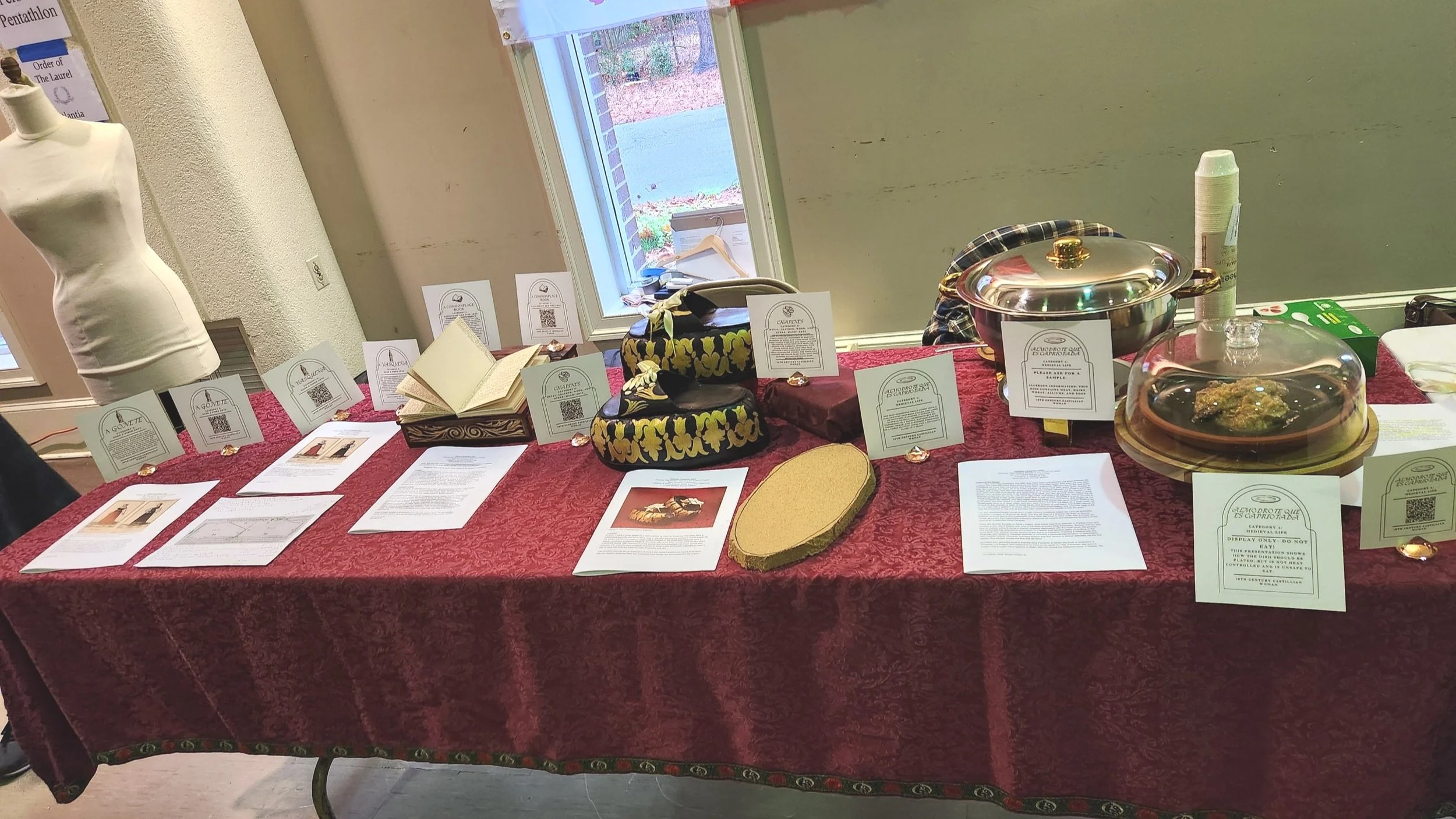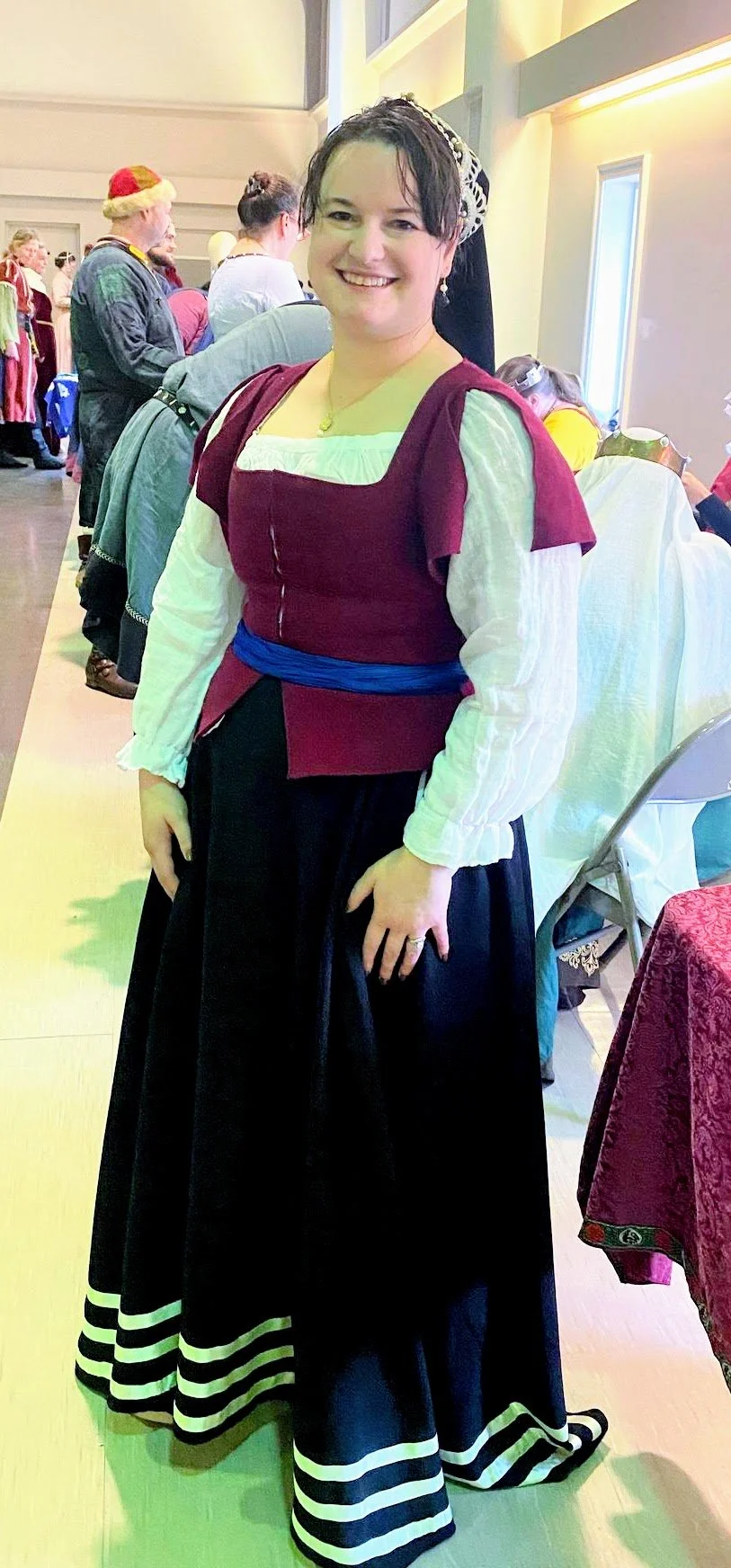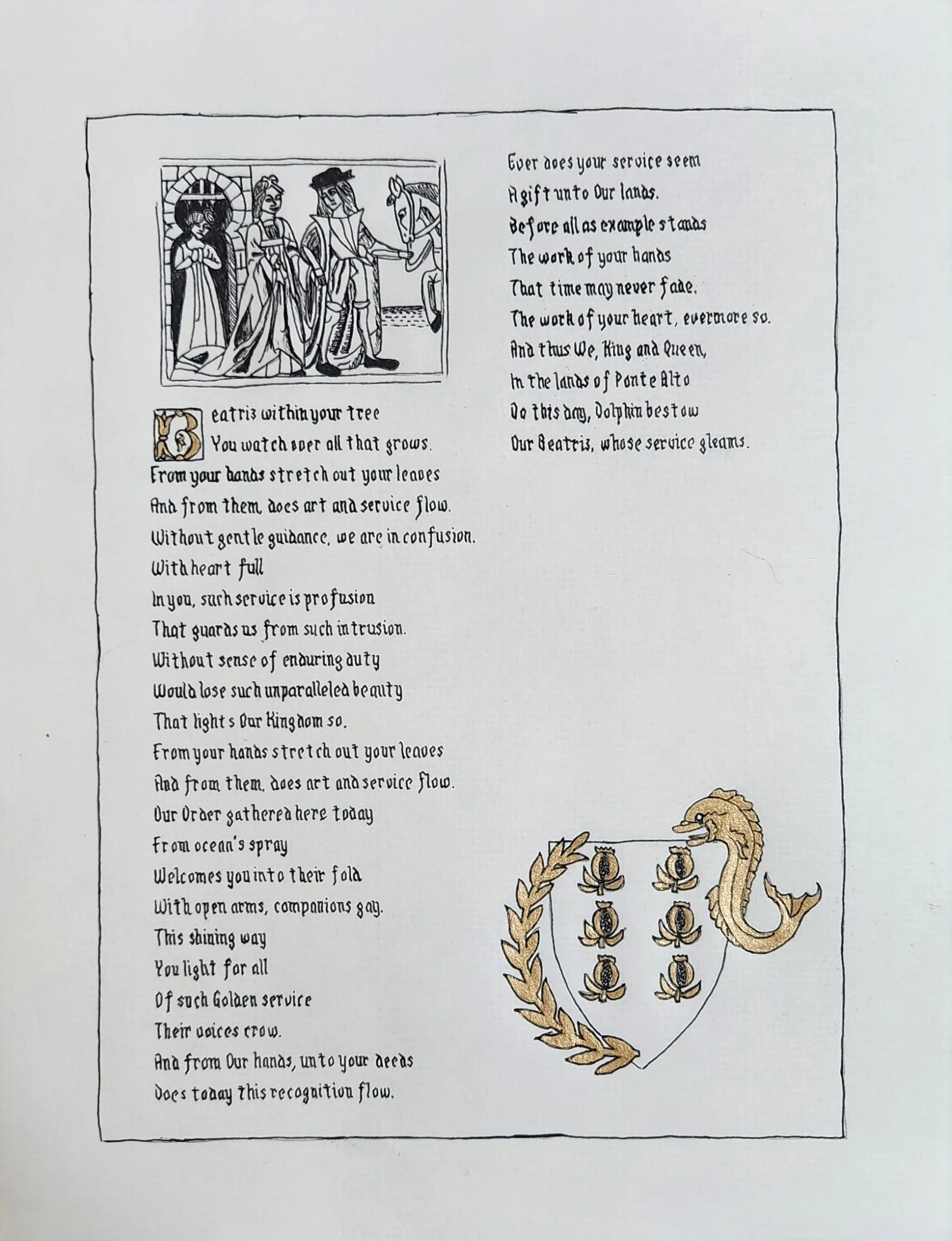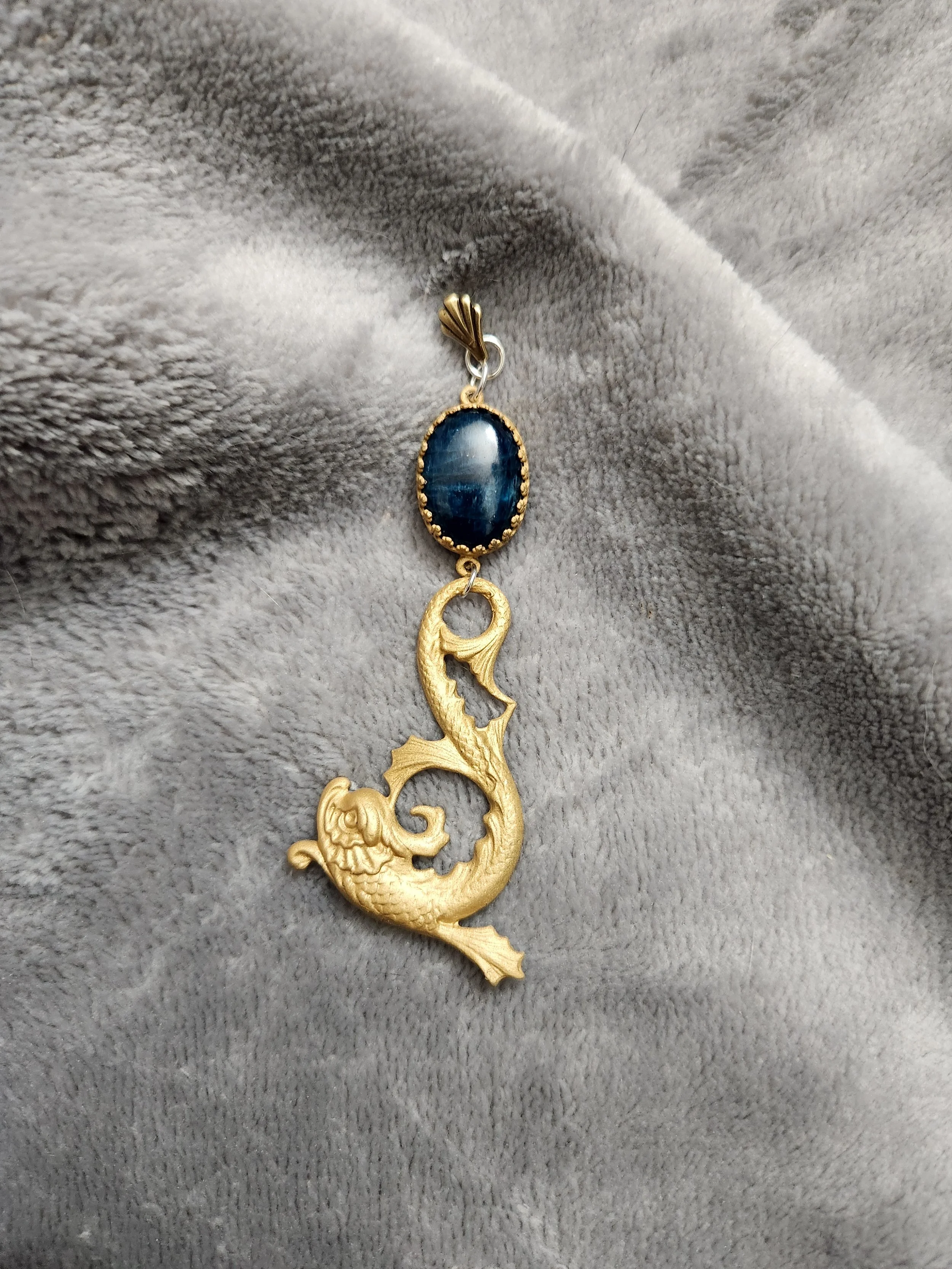March 2024: Now What? Turns Out, Quite A Lot
My March goals were:
Survive KASF.
Start on the body linens for Pennsic.
Possibly start on the Gold Saya.
So starting with Goal #1: Survive KASF.
My Persona Pentathlon display in all its glory!
My full Pentathlon outfit and definitely one of my new favorite things.
Kingdom Arts and Sciences Festival is one of my favorite events every year. Spending it essentially tied to the biggest display I’ve ever done seemed a bit daunting. I was worried I wasn’t going to feel like I was getting the full KASF experience. I am so glad I did it though. Persona Pentathlon has been a labor of love for me for so long and getting to actually talk to people who really wanted to hear about what I made and learned was so incredible. People actually sat and read my documentation (all 77 pages of it) and wanted to talk about it! The level of knowledge sharing in both directions- because I got some fantastic feedback and opportunities to improve- was just absolutely amazing. It is an experience of a lot of big feelings, but I really do recommend giving Pentathlon a shot.
From a personal growth perspective, I think I can confidently say I am a better artisan today than I was before because of this competition, and not just because I won. The things I have learned about approaching projects, trying new things, and greatly improving how I do documentation will be with me forever. I’m especially proud of the fact that of all the 5 categories items get scored on (documentation, authenticity, complexity, workmanship, and overall impression) that documentation and then workmanship were my best performing categories, with authenticity being a very close third.
Feedback wise, there are a few points that really stand out as things I want to try soon.
On the gonete, it was advised I look into German clothing to see how they incorporated both lacing rings AND hooks and eyes to get that really smooth front. I think the theory here is that the lacing takes the weight of the tension and the hooks and eyes are just to hold the front flaps together. I really want to explore this strategy for my next gonete.
Looking into maker spaces that might have the band saw and power sander I need to give the chapines another go. I would love to do a pair that’s a bit more vertical and to re-explore some of the sole/body attachments and leather tooling that I struggled with this time in the not too distant future.
Find 6 people or so who want to sit down and have a meal together and go whole hog on the almodrote. Pull out all the stops and make it with partridge and my ideal cheese choice. This may need to involve the development of a couple extra recipes so we can have a full meal but I going to pretend for now that that doesn’t involve committing myself to studying full menu development from Nola just yet.
I’ll be doing an in person class for Ponte Alto on my Pentathlon experience in April, as well as a University Instructor Spotlight. I’m hoping to keep both focused on the actual process of doing Pentathlon vs the final product pieces. I’ll bring them with me for the in person class because everyone likes a show and tell, but hopefully we’ll talk more about what is Pentathlon, why do it, and the strategies I used to approach the project as a whole.
Goal #2: start on the body linens for Pennsic.
This is a pretty easy one. Thankfully, I have my preferred patterns pretty well down for these items so knocking them out is fairly straight forward. In the days after KASF, while I planned for the Gold (now Vermeer) Saya, I made a pair of calzas. It took me about 4 days from start to finish. The one thing I did differently on this pair is instead of hemming the leg openings, I added applied bands like at the waist. My thinking for this was to:
Test a possibility for future embellishments like embroidery. It’s a lot easier to embroider a band than it is to try to manipulate an entire garment. Assuming this strategy worked, I would be much more readily able to try to do some of the fancier body linens I’ve explored in the past.
Test out (in the future) adding eyelets for points. Many of the inventories that discuss these garments note that the medias calzas, the stockings and their linen body layer, were attached to the calzas with sets of points. I have some medias calzas on my list in the not too distant future that I would like to be able to tie to the bottom of the calzas. I think it would overall be more successful than garters, and possibly more comfortable. Now, I don’t have any medias calzas that I can test it out with, but I think we’ll put those down for next month as one of my smaller project ideas.
Goal #3: possibly start on the Gold saya.
Fabric choices for the saya. From left to right: Mustard Cotton-Linen blend from Renaissance Fabrics and Moroccan Blue linen from Fabrics-Store. The black pictured ended up not getting used.
This became a definite possibility quite quickly. I think alternating between body linens and not body linens as well as big vs little projects will help me from becoming bored or burnt out on any one project. So while I was working up the calzas, I also started prepping the fabric for the next project. This one was an exciting project for me. It would be the first major piece made with the new knowledge post Pentathlon projects that could incorporate my learning.
It’s been a little while since I last did a stand alone project post and there’s quite a few aspects of this one that I think are worth discussing so more on this particular project can be found at its own post. I’m planning on debuting it at Storvik Novice/Highland Foorde Investiture and I’m very excited to finally start having more than the same two dresses to wear to events all the time.
I also did a few things this month that were a little brave for me this month that were not on my goals list.
The first was to purchase a new dress form. My last dress form, z”l, was a used adjustable dress form that Sof’ia and I found at a thrift store. She came pre-loved and that came with mechanical complications. My measurements are also not really conducive to standard or adjustable forms. I have a fairly extreme waist : hip and waist : bust ratio and usually adjustable forms can’t match those. I used to leave my form set for my bust and hip sizes, use her for getting those parts right, and then take in the waist later. This made for some interesting tailoring challenges but also meant that using my form to display my garb was really challenging too. This month I decided to do something about it and bought myself a really nice dress form. The hive mind has named her Lady Catherine Montagu of Sandringham (Lady Catherine for short, an anagram of what she does best, which is standing in a corner making my cats uncomfortable) and she’s my new best garb friend.
Lady Catherine, wearing the Vermeer Saya in her first day on duty.
This form came with a padding kit and cover so I was able to pad it out and customize it to my needs and measurements. This padding makes it a squishier form, so it can squeeze into my supportive garb much more easily than an entirely rigid one. The padding process was a lot easier knowing my own measurements beforehand. I knew exactly how much the hips and bust needed to go up so it was really just a matter of experimenting with combinations of pads to get to those numbers. I’m really pleased with how the pads ended up working, and just needed to pin the ever living heck out of them to get them smooth under the cover.
One kind of unexpected benefit of this form is a bit of an accessibility thing. Due to an injury as a child, my hips are misaligned and the padding allowed me to actually account for that misalignment. I definitely had kind of a moment getting to see my actual, real-life wonkiness on a form so I could hem to my hem, not some expectation of perfect symmetry.
The cast iron base did arrive broken (hence the slate coaster underneath it in the picture to the left), but the customer service team at Fabulous Fit has been fantastic throughout this whole process and I highly recommend this dress form. The one major downside is that Lady Catherine is a rather imposing figure. She is tall. At her absolute shortest, the bust line is up at my eye line. I will have to cut down the main pole to get her to a more manageable height. She is about a foot too tall, so I’m thinking of cutting her down about 6-8” so I can still hem in the air a little bit. The form I got is the Fabulous Fit form in Global Standard. I plan to use fabric tape to plot out some of my standard measurements on her.
The next thing was that I revisited once again doing scribal stuff. At Ponte Alto Investiture, Bea was awarded her Golden Dolphin. At the time we found out, I also knew that all the scribes we know and usually ask to do family scrolls were swamped. I wanted Bea to have a scroll that was meaningful to her and her persona and so armed, with Canva, a light table, and a very patient husband who helped with some of the fiddly painting bits, I decided to give it a go myself.
I borrowed a woodcutting, an illuminated capital, and a poem format/inspiration from a published copy of the story of Amadis de Gaula. Amadis de Gaula is a Spanish chivalric romance that was originally published in 1508 (Encyclopedia Britannica) and follows the love story of a knight, Amadis, and his lady love Oriana. The version used for this project, held at the Library of Congress, was printed in 1531 and contains the original four books of the story of Amadis. The elements on the scroll are from a little bit all over the place in the story. The miniature at the top left is pulled from page 528, and shows Amadis and the Infanta Estrelleta, who will be marrying Amadis’s cousin. The "B” capital comes from page 105, in which a character is hunting for a specific horse. And lastly, the poem comes from page 202, and is a poem from the son of Amadis and Oriana to his love interest, Leonorina.
Process wise, I decided to start with the poem. I took the poem as written in the image, typed it up in Spanish then translated it. I then also mapped out the rhyme scheme and noted any repeating motifs/lines. From there, I was able to turn out a pretty reasonable poem using elements of the original in praise of Bea’s service. I debated translating my poem back into Spanish, but ultimately decided to leave it in English.
I mocked up the design and layout in Canva, having to use my free account because Bea and I share a pro account. From there, I traced it out a few times to test out my various pen options before trying it on nicer paper. Once happy with the design and copy, Evan helped me paint in the gold bits. I wanted to keep the scroll itself fairly monochrome, since the exemplar is printed text and woodcut prints. Bea’s heraldry is gold pomegranates on a red field, so we ended up getting a frame with red matting to bring some color and life to it.
Evan and I also made two Golden Dolphin medallions/badge pins. I got my Golden Dolphin at KASF and Marguerite gave me her medallion, so now we have household medallions for both Pearls and Golden Dolphins. Knowing I’d need a new Golden Dolphin myself fairly quickly after, I went hunting for something I could use. Most of the medallions available online are pretty notably modern, and while beautiful, don’t really fit my goals for my SCA kit. I ended up finding some great jewelry findings online that served to make this into a pin, much like I used to wear my Pearl and Evan agreed to help me paint them back to a true gold color. I got a gorgeous, rich blue apatite for the cabochon. It reminds me of the ocean and I love how it works with the dolphin. Most of the findings came with multiples, so Bea also got one of these along with her household medallion.
While jewelry isn’t usually my bag of tricks either, Joann’s was having some fabulous sales (which was bittersweet and probably tied to their bankruptcy filing) and I grabbed some beads to try a red paternoster. This paternoster has another pomander on it, which is easily my favorite agnostic but still appropriate paternoster terminal and is made with a beautiful veined natural red stone. It’s also much shorter than my other pieces. Many pieces seen in art are small enough to be bracelets or held over the wrist, and this one does a great job of that. I decided to add Queen Mary Isabel’s Undine token, which I received at Ponte Alto Investiture, to mine as well, as a way to keep it somewhere special and because it fit the piece really nicely. This was a great day project at Investiture!
Lastly, I finally made a Mariana Ruiz de Medina YouTube channel. I’ve wanted to expand my ability to create content to video content more, especially with my classes. The Courses feature allows embedding from YouTube videos as part of the function, and doesn’t require a paid subscription to the Courses add-on to use it that way. I tested it out with the electronic documentation course that I did with the University recording team last University and that went great. So, at last, Mariana actually has a social media presence outside of just my nickname on Facebook. This may encourage me to actually try creating non-class content, which is something I’ve been very hesitant to do in the past. Thankfully, my new business cards made for some really versatile branding material and that imagery is now up as both my YouTube banner, my new website banner, and finally a custom favicon. It’s mostly just my heraldry but I love the subtle images of the “what does Mariana do?” without having to spell it out for folks.
April is going to be the month of persona development classes. I’ve agreed to teach not one, but three over the course of the month. First up is The What’s and Why’s of Persona Development at Novice Tourney. Next will be a talk on my Persona Pentathlon experiences for my home barony at a fighter practice. Lastly, I agreed to give a an online version of the Pentathlon class as an Instructor Spotlight for the University of Atlantia online!
My April goals are:
Finish all my various class materials.
Big project: a 14th Century saya from the Medieval Blue linen I purchased in February.
Littler project: a set of both wool and linen medias calzas to go with the calzas I made this month.
Stretch goal: a camisa with narrow sleeves to go with that blue 14th century saya,








